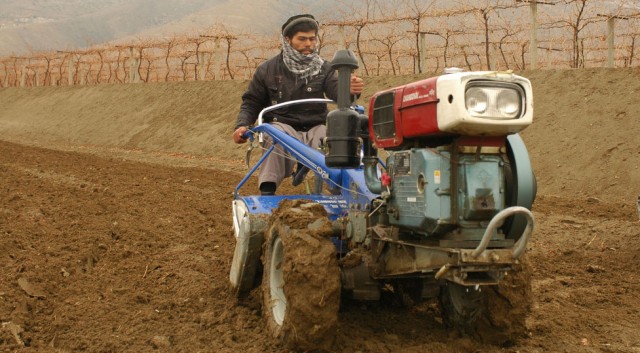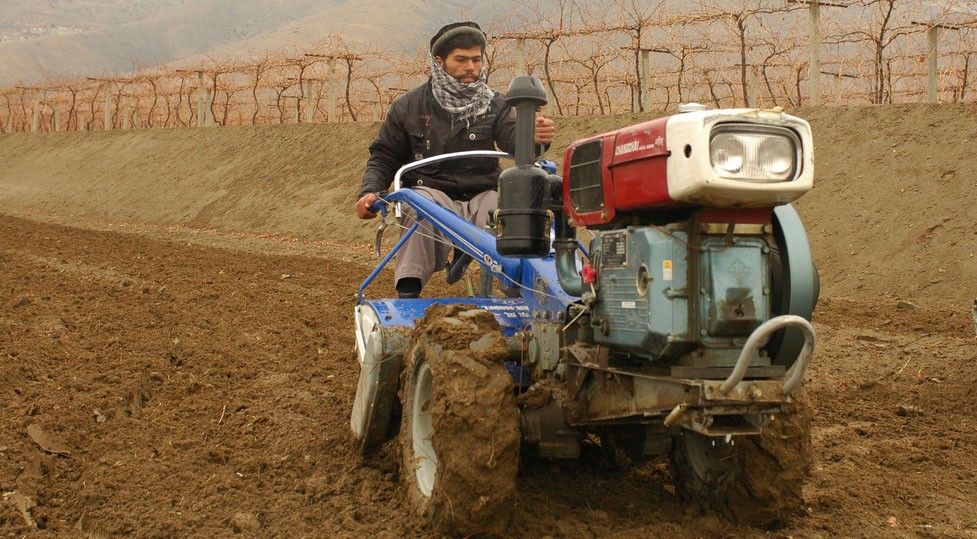
KABUL, Afghanistan, Feb. 9, 2011 -- Afghan farmers were tearing up the dirt Sunday as they received the keys to 50 two-wheeled tractors.
Afghanistan currently produces less food than its people need. The 50 tractors are the continuation of an effort to mechanize Afghanistan and increase the productivity of mid-sized farms that grow produce for the Afghan market.
The joint effort between Afghanistan's Ministry of Agriculture, Irrigation, and Livestock; the U .S. Agency for International Development; and International Relief and Development is working to provide up to 6,000 tractors to Afghan farmers by March.
Many Afghan farmers use oxen and human labor to plow land and plant seed. These tractors will increase efficiency of farms that use them.
"In an hour spent working on the farm you can harvest and plow more land," said Suzanne Poland, food security team leader, USAID. "There are also seed drills so you can plant faster."
Only 12 percent of Afghanistan's land is suitable for growing produce and most mid-sized Afghan farms work small, fragmented, hilly fields where the smaller, two-wheel tractors are more effective than four-wheel tractors.
The two-wheel tractors costs almost $4,000 each compared to $8,000 for the cheapest four-wheel tractor. But even at this price, the two-wheel tractors were unaffordable for those with mid-sized farms.
"The agriculture mechanization [of Afghanistan] was completely destroyed. It needed some renovation and reactivation," said Kasim Rahamy, owner of the company that imported the tractors.
Part of that reactivation was to sell the tractors to the farmers at a subsidized price.
"The U.S. Government funded this project as a grant to the Afghan government; 35 percent of the cost will be paid by Afghan farmers," said Agricultural Minister Mohammad Asif Rahimi.
But the farmers were not just handed a set of keys to a new tractor. Before the farmers received the tractors, they had to qualify for the program and attend a training course.
To be eligible, the farmers had to agree not to resell the tractor, reside in one of 18 central and western provinces, own or rent one to 25 hectares of land, and be willing to pay 65,000 Afghani, approximately $1,400, for the tractor and attachments.
"The farmers who are purchasing these tractors received five days training on these tractors as part of the program," said Abassador Karl Eikenberry, U.S. Ambassador to Afghanistan.
Even after purchase, the farmers will receive support for their new tractors.
"They [the farmers] will be buying local parts from local dealers. There are 250 mechanics trained now, and they all have access to spare parts," Poland said.
"Our mechanics can work with the farmers and they will import tools and spare parts. These tractors are guaranteed for one year," said Rahimi.
As part of the training, each farmer was also provided with a tool kit.
"If the farmers have any technical difficulties they will be able to repair their tractors," said Rahimi.
As part of the sustainability of this program, the long-term goal is to make it where Afghanistan farmers won't need the help of government subsidies to purchase tractors in the future.
"Once we have spare parts and tools in our country, the people will be able to purchase these tractors," said Rahimi.
"We are linking the farmers up with these dealerships so it will be sustainable," said Poland.
The two-wheel tractors are expected to help farmers plant and harvest multiple crops per year, reduce labor required, and reduce production costs to generate more income for farmers.
The end result is expected to be a sustainable system where Afghan farmers can purchase and maintain their own tractors without government intervention or subsidies.
While the tractors will significantly increase the ability of farmers to till land, the tractors also serve a variety of uses including transporting up to 1.5 tons in the accompanying trailer and reaping crops.
"These tractors can also be used for irrigation pumps, for flour mills, and for mobile electric generators," said Eikenberry.
"These tractors are one more concrete example of America's long-term commitment, to a partnership with the Government of Afghanistan and eternal friendship with the Afghan people," said Eikenberry.
Related Links:
Agribusiness teams help Afghan farmers find simple solutions
Farmers helping train troops for Afghanistan
Army ag advisor helps Maysan crops grow one drip at a time
Iowa ADT brings tractor, hope to Chowkay
Hoosier Soldiers share poultry knowledge in Afghanistan

Social Sharing